Plymouth Rock is one of the most popular chicken breeds in the world. This American dual-purpose breed has been cherished for over a century because it provides both a steady supply of brown eggs and flavorful meat.
The breed comes in several beautiful recognized varieties such as Barred, Black, Buff, and Columbian. Poultry standards also recognize additional colors like White, Partridge, and Silver Penciled, making Plymouth Rocks a visually striking choice for any flock.
Backyard keepers often choose Plymouth Rock chickens because they are hardy, friendly, and easy to raise. As a dual-purpose chicken, they offer families both eggs and meat without demanding much extra care. If you are planning to raise Plymouth Rock chickens, this guide will give you everything you need to get started.
In the following sections, you’ll learn the complete history of the Plymouth Rock chicken, its lifespan, temperament, egg production, size, colors, fun facts, and much more. By the end, you’ll see why this breed remains a favorite for beginners and experienced poultry keepers alike.
What is Plymouth Rock chicken?
Plymouth Rock is an American farm chicken breed developed in the 19th century and officially recognized in 1874. It was created as a dual-purpose chicken that could provide families with both meat and eggs, making it a reliable and practical choice for homesteads.
Today, you can buy Plymouth Rock chicks in the United States for about $5–6 USD each. With their calm nature and attractive appearance, they continue to be one of the most appealing and accessible chicken breeds available.
History of Plymouth Rock Chicken
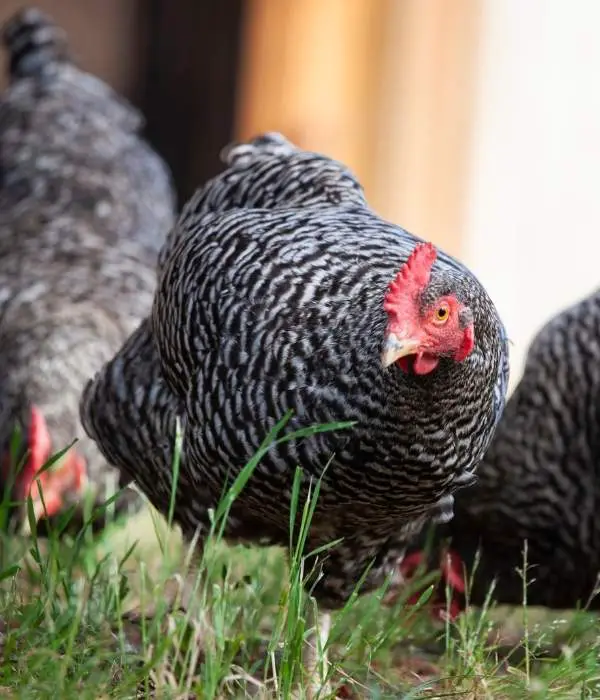
The Plymouth Rock chicken was first exhibited in Boston in 1849, during what is considered America’s first poultry show. After that initial appearance, the breed seemed to vanish from exhibition records for about twenty years, before reemerging in 1869 in Worcester, Massachusetts.
By 1869, breeders were experimenting with crosses involving Black Java hens and single-combed Dominique birds, aiming to refine the barred plumage trait. Some historical accounts also mention contributions from Cochin, Brahma, and other breeds during the breed’s development.
Over time, the Plymouth Rock chicken grew in popularity across the United States. In fact, until around World War II, the Barred Plymouth Rock variety was among the most commonly raised dual-purpose birds on small farms.
The Barred variety was included in the first American Poultry Association Standard in 1874, setting the benchmark for the breed. Other color varieties—Buff, White, Silver Penciled, Partridge, Columbian, and Blue—were added later as the breed matured.
Also read: Top 11 Classic American Chicken Breeds
Lifespan
Plymouth Rocks are among the longer-living breeds when well cared for. On average, Plymouth Rock chickens live about 6 to 8 years, though some have been known to reach 10 years or more under ideal conditions.
Recognized Varieties of Plymouth Rock Chicken
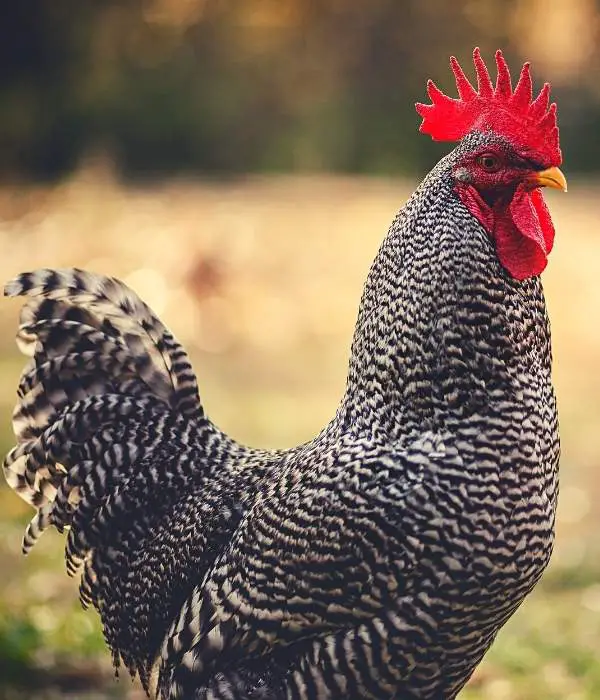
In the United States, the American Poultry Association (APA) recognizes seven color varieties for the standard-size Plymouth Rock:
- Barred
- Blue
- Buff
- Columbian
- Partridge
- Silver Penciled
- White
For bantam (miniature) Plymouth Rocks, the APA accepts eight varieties in the Single Comb Clean Legged class:
- Barred
- Black
- Blue
- Buff
- Columbian
- Partridge
- Silver Penciled
- White Meyer Hatchery Blog+1
In Europe, the Entente Européenne d’Aviculture et de Cuniculture lists ten plumage varieties for Plymouth Rock chickens. Meanwhile, the Poultry Club of Great Britain (PCGB) recognizes six varieties: Barred, Black, Buff, Columbian, White, and Silver Pencilled.
Plymouth Rock Chicken Vs. Barred Rock Chicken
Most people wonder about the difference between Plymouth Rock vs. Barred Rock chickens. The truth is, there isn’t a separate breed called Barred Rock. Instead, Barred Rock is a recognized color variety of the Plymouth Rock chicken.
The Barred Plymouth Rock is the original and most famous variety, featuring striking black-and-white striped plumage. Because it has been the most widely bred and promoted type, many people casually call it the “Barred Rock” as if it were a breed of its own.
So if you see a Barred Rock chicken, don’t get confused—it’s simply the most popular variety of the Plymouth Rock breed, known worldwide for its beauty, egg-laying ability, and friendly temperament.
Egg Production
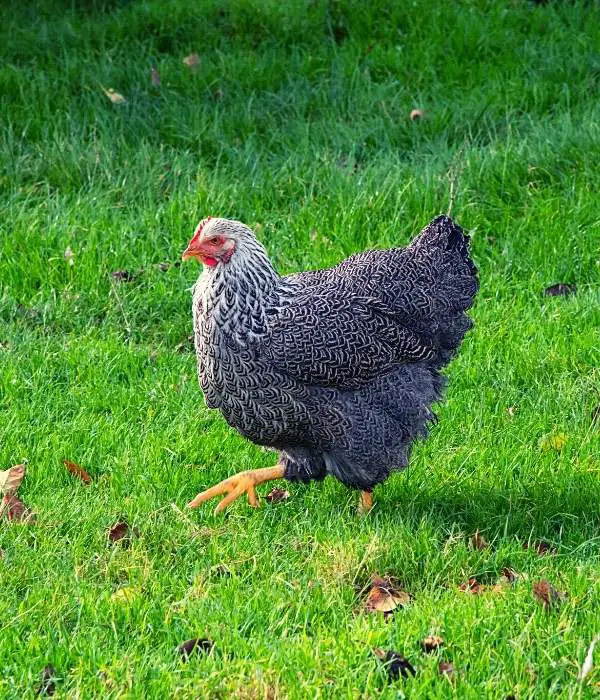
Because the Plymouth Rock chicken is a dual-purpose breed, it’s also a respectable layer. After reaching maturity (about 5–6 months old), hens will typically lay 4–5 large brown eggs per week. Over the full year, that averages to around 200 eggs annually.
Some stronger strains or well-kept hens can exceed this and reach 220–280 eggs per year, especially in their prime laying years.
Egg production may taper off after the first few years, but many hens continue laying — albeit at reduced rates — through 6 to 8 years, and occasionally even longer.
You can also check out our list of the best egg-laying chicken breeds to see where Plymouth Rocks stand among top layers.
Temperament
Plymouth Rock chickens are known for being friendly, calm, and docile. They quickly learn to trust their keepers, and children especially love playing with them. Their gentle nature makes them an excellent choice for family flocks.
Both roosters and hens of this breed are usually easy to handle and rarely aggressive, which makes them a perfect option for beginner chicken raisers. Unlike more aggressive breeds such as Aseel chickens, you won’t see much fighting or feather pecking with Plymouth Rocks.
They get along well with their flock mates, graze together peacefully, and absolutely love to free-range. If you have space in your backyard, Plymouth Rock chickens will thrive in it.
Offering occasional chicken treats helps build trust. Within a few days, many of these birds will follow you around and even hop up to perch on your hands or shoulders, making them one of the most people-friendly backyard chicken breeds.
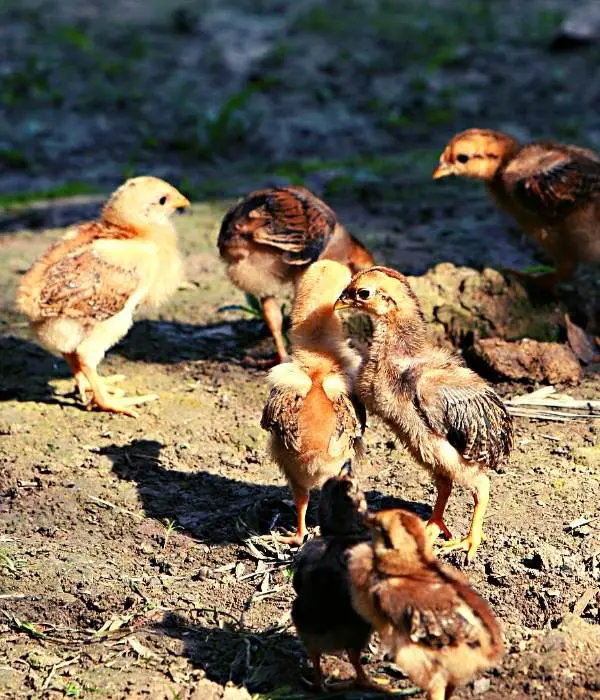
Color, Size, Appearance, Characteristics of Plymouth Rock Chicken
Color Varieties
The American Poultry Association (APA) currently recognizes seven color varieties for the standard-sized Plymouth Rock chicken: Barred, Blue, Buff, Columbian, Partridge, Silver Penciled, and White.
While Barred is by far the most common variety, each color has its own charm and appeal in backyard flocks.
Size & Weight
Plymouth Rocks are solid, heavy birds when mature — true to their dual-purpose heritage (for both meat and eggs).
- In standard (large) size:
• Rooster (cock): ~ 9.5 lb (≈ 4.3 kg)
• Hen: ~ 7.5 lb (≈ 3.4 kg) - In bantam size:
• Rooster: ~ 3.0 lb (≈ 1.36 kg)
• Hen: ~ 2.5 lb (≈ 1.13 kg)
Of course, actual weights can vary depending on strain, diet, and environment.
Appearance
Plymouth Rock chickens are striking and robust. Their body shape is broad, with a deep, full breast and a gently sloping back.
Here are key features:
- Plumage pattern: In the Barred variety, males typically show nearly equal black-and-white bars, while females have wider dark (black) bars than white ones.
- Skin & legs: yellow skin, clean (no feathering on legs), and four toes per foot.
- Facial features: red comb, wattles, earlobes; beak is horn-colored or yellow; eyes a reddish bay.
- Comb: single comb with five serrated points — typical of this breed.
Because of their sturdy build and elegant plumage, Plymouth Rock chickens are both practical and attractive additions to family flocks.
Characteristics
Plymouth Rock chickens are well known for being a friendly and adaptable breed, yet they also serve practical business purposes as a reliable dual-purpose bird. They thrive equally well in free-range environments or in confinement, making them suitable for both backyard flocks and small farms.
Most strains of Plymouth Rock are excellent egg layers, and many hens also prove to be attentive mothers that will raise chicks successfully. The roosters are generally sturdy and impressive in build, while hens are equally attractive with their soft, rounded bodies.
Both males and females are usually calm and non-aggressive. Hens may peck lightly if you approach their chicks, but this is typical protective behavior rather than true aggression.
The breed is also known for its dense plumage. All Plymouth Rocks are fluffy chickens, well-feathered birds, which makes them hardy in colder climates.
However, because of their heavier bodies and thick feathering, they may be more sensitive to high summer heat. Providing shade and cool water is especially important in warmer regions.
If you are planning to buy Plymouth Rock chickens for breeding, it’s best to choose strong, standard-sized birds. Larger fowl tend to produce healthier, high-quality chicks and maintain the breed’s traditional characteristics.
Benefits of Raising Plymouth Rock Chicken
Here are some of the main benefits of raising Plymouth Rock chickens:
- Great for backyard flocks – Plymouth Rocks are an excellent choice if you want to raise chickens in your backyard. They adapt well to different environments and are easy to manage.
- Beginner-friendly – This breed is hardy and easy to grow, making it ideal for new chicken keepers who want to start poultry farming without stress.
- Attractive and friendly – While the Barred Rock is the most popular variety, all color types are striking. If you want a breed that is both beautiful and people-friendly, Plymouth Rock chickens are a strong option.
- Peaceful grazers – These chickens enjoy foraging near their owners and rarely wander far. Occasionally, they may hop over low chicken wire, so providing a secure fence is a good idea.
- Quiet breed – Compared to many other chicken breeds, Plymouth Rocks are not overly loud. Roosters crow but generally in a moderate tone, while hens are not noisy enough to disturb neighbors.
- Dual-purpose value – As a classic dual-purpose breed, Plymouth Rock hens lay about 200–220 brown eggs per year, and their large body size (standard roosters around 9.5 lb, hens 7.5 lb) makes them suitable for meat as well.
- Kid-friendly – These chickens are calm and docile, so children often love playing with them. Offering treats like mealworms will quickly earn their trust and bring out their energetic, playful side.
- Good mothers – Plymouth Rock hens are attentive and caring mothers. They hatch eggs reliably and raise chicks with protective, nurturing behavior.
How to Take Care of Plymouth Rock Chickens
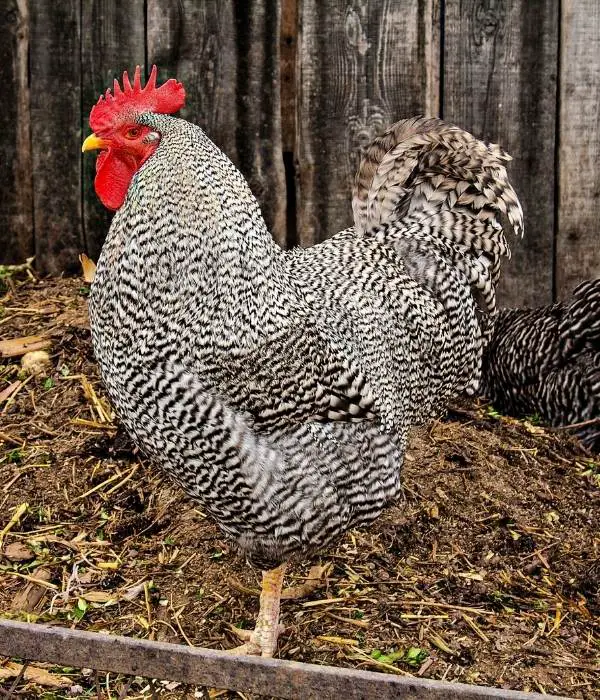
The Plymouth Rock chicken has a major benefit of ease of management. Plymouth Rocks are great for beginner chicken owners.
Taking care to pay special attention to certain factors like temperature and climate, predators, and coop design.
Housing & Environment
– Provide the chickens with a secure coop that has solid walls, a ventilated roof, and protection from drafts. Adequate ventilation will be helpful in hot weather, while insulation will be helpful in cold months.
– Use good fencing (hardware cloth or welded wire) around the run, including overhead cover to prevent raptor attacks.
– Make room for adequate dust bathing areas and perches. The Plymouth Rock breed loves both of these amenities and they contribute to feather care and behavioral enrichment.
– In hot climates, make sure they have shade, airflow, and fresh (cool) drinking water. These birds cannot tolerate heat well.
– In winter climates or uncomfortable cold temperatures, consider (especially for roosters) providing protection for their combs and wattles from frostbite and adding dry bedding so they can stay warm.
Feeding & Nutrition
– Use a balanced layer feed once hens begin laying (with ~16–18% protein) along with grit to aid digestion.
– Provide calcium supplements (crushed oyster shell or eggshells) for healthy eggshell formation.
– Offer fresh water at all times. In hot weather, water consumption rises, so keep drinkers shaded and cleaned.
– Supplement with greens, insects, or kitchen scraps for enrichment, but avoid overfeeding treats (can cause obesity).
Predator & Security Considerations
– Because Plymouth Rock chickens are calm and docile, they may not run fast when threatened. That increases their risk from predators.
– Use strong fencing, and consider burying mesh underground to prevent predators digging in.
– In more remote or forested areas, electric fencing or motion-activated deterrents can provide extra protection.
– Lock them in the coop at night; many predators strike after dark.
Health, Parasites & Maintenance
– Regularly inspect for mites, lice, and internal parasites. Provide space for dust baths which help chickens self-clean.
– Keep the coop clean and dry — damp bedding encourages disease and respiratory issues.
– Watch for signs of overheating in hot weather (panting, spreading wings) or cold stress in winter.
– Vaccinate or follow local recommendations for common poultry diseases.
Also read: Appenzeller Spitzhauben Chickens
FAQs About Plymouth Rock Chickens
How long do Plymouth Rock chickens live?
Most Plymouth Rock chickens have a lifespan of approximately 6 to 8 years, although some have been known to exceed 10 years when given excellent care.
How many eggs do Plymouth Rock chickens lay?
A normal Plymouth Rock hen produces approximately 200 to 280 brown eggs annually, which works out to about 4 to 5 eggs weekly.
When do Plymouth Rock chickens start laying eggs?
Plymouth Rock hens usually start laying eggs at between 18 and 20 weeks, or about 5 months.
How long do Plymouth Rock chickens lay eggs?
They are most productive for the first 2 – 3 years of life. After that, egg production slows, although many hens will lay eggs sporadically throughout their lives.
Are Plymouth Rock chickens friendly?
Yes, Plymouth Rocks are calm, docile, and friendly, allowing them to be handled easily. They are often suggested as good chickens for families and for first-time chicken keepers.
What does a Plymouth Rock chicken look like?
Plymouth Rocks have a broad, robust body, yellow skin and yellow legs, red wattles and combs, and bright eyes. The most recognizable of the Plymouth Rock chickens is the Barred Plymouth Rock, identified by its distinct black and white striped plumage, although there are a number of other color varieties of the Plymouth Rock.
How big do Plymouth Rock chickens get?
Roosters of a standard size generally weigh between 9 and 10 pounds, while hens can weigh anywhere from 7 to 8 pounds. Bantam Plymouth Rocks are considerably smaller, with roosters weighing about 3 pounds and hens somewhat lighter at 2.5 pounds.
What does a Plymouth Rock chicken eat?
They do well on a combination of a good brand of poultry feed plus additional sources of calcium for layers. They also enjoy free ranging for grass and bugs and generally like a little kitchen scraps as well when you feel generous.
How much do Plymouth Rock chickens cost?
Chicks of the Plymouth Rock variety start at a price of $5 to $15 per chick (depending on the hatchery and exact type) for day old chicks.
Summary
The Plymouth Rock chicken is a classic dual-purpose breed, valued for both its steady egg production and quality meat.
These hardy birds adapt well to different environments — they’re happy free-ranging in the yard or living comfortably in a coop.
For beginners, Plymouth Rocks are one of the easiest breeds to raise thanks to their calm, friendly nature.
For small farms or backyard flocks, they also deliver practical benefits, producing 200–280 eggs a year while growing into a solid table bird.
Whether you keep them for business or as family-friendly pets, Plymouth Rock chickens remain a reliable and rewarding choice for poultry keepers everywhere.
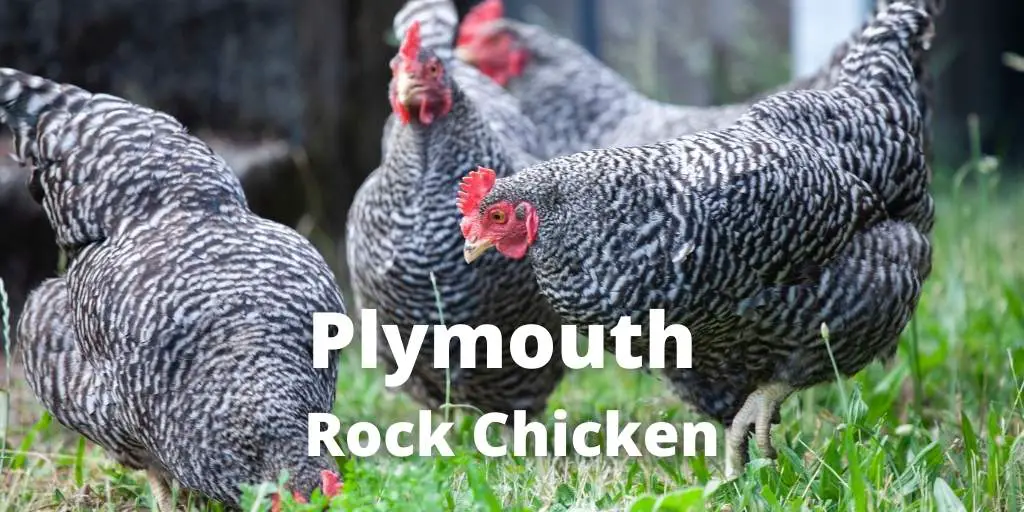
I have 3 bared Plymouth rock hens that lay white eggs, and I thought Plymouth rocks lay brown eggs.
Hi Judy, thanks for writing here
That’s a great observation, and you’re right — true Plymouth Rock hens should lay light to medium brown eggs, not white. If your hens are laying white eggs, there are a couple of possibilities:
Breed mix-up at the hatchery – Sometimes hatcheries mislabel or mix Barred Plymouth Rocks with similar-looking breeds like Dominique or even Cuckoo Leghorns, which do lay white eggs.
Crossbreeding – If your hens came from a mixed flock, they may be Barred Rock crosses rather than purebred Plymouth Rocks. Crosses with Leghorns or other white-egg layers can result in barred birds that lay white eggs.
If egg color is important for your flock, the best way to be sure you have purebred Plymouth Rocks is to source them from a breeder who maintains APA-standard bloodlines.
Bijaya Kumar